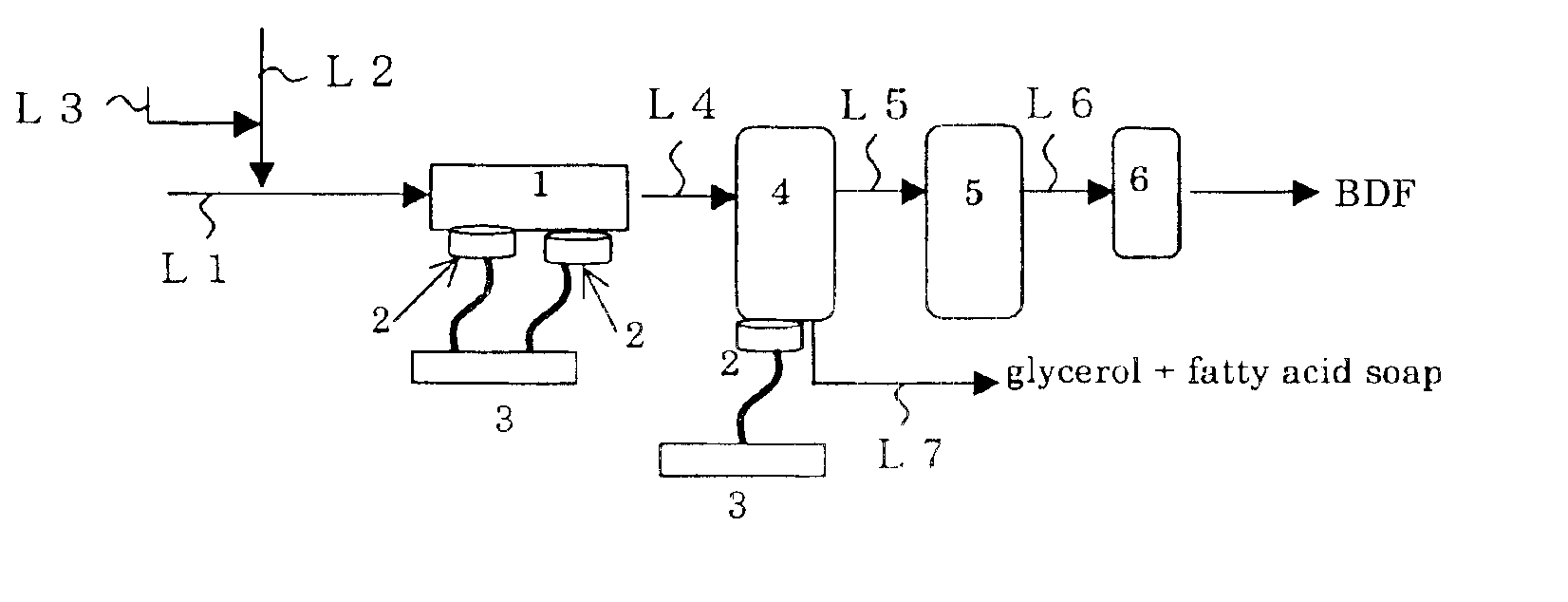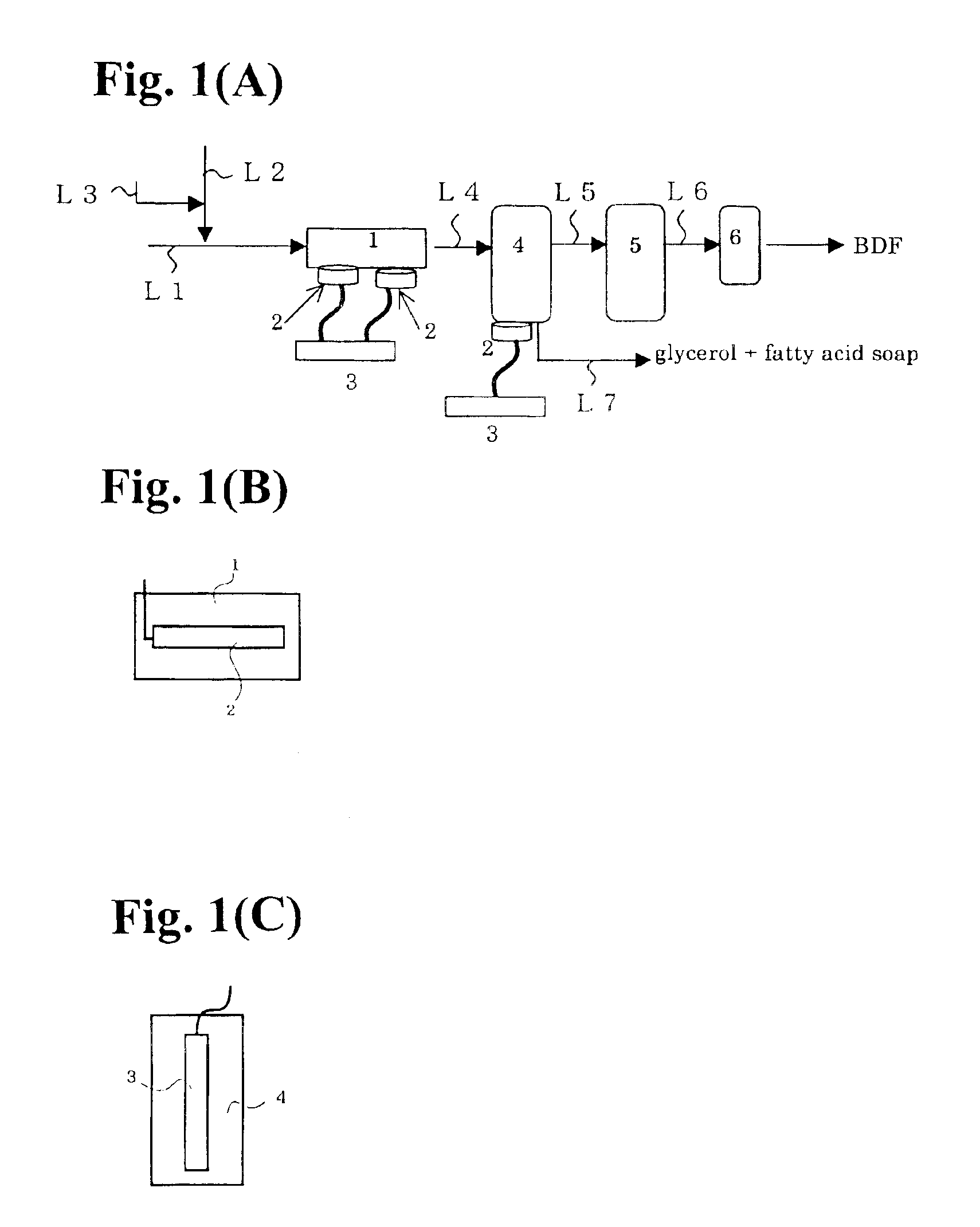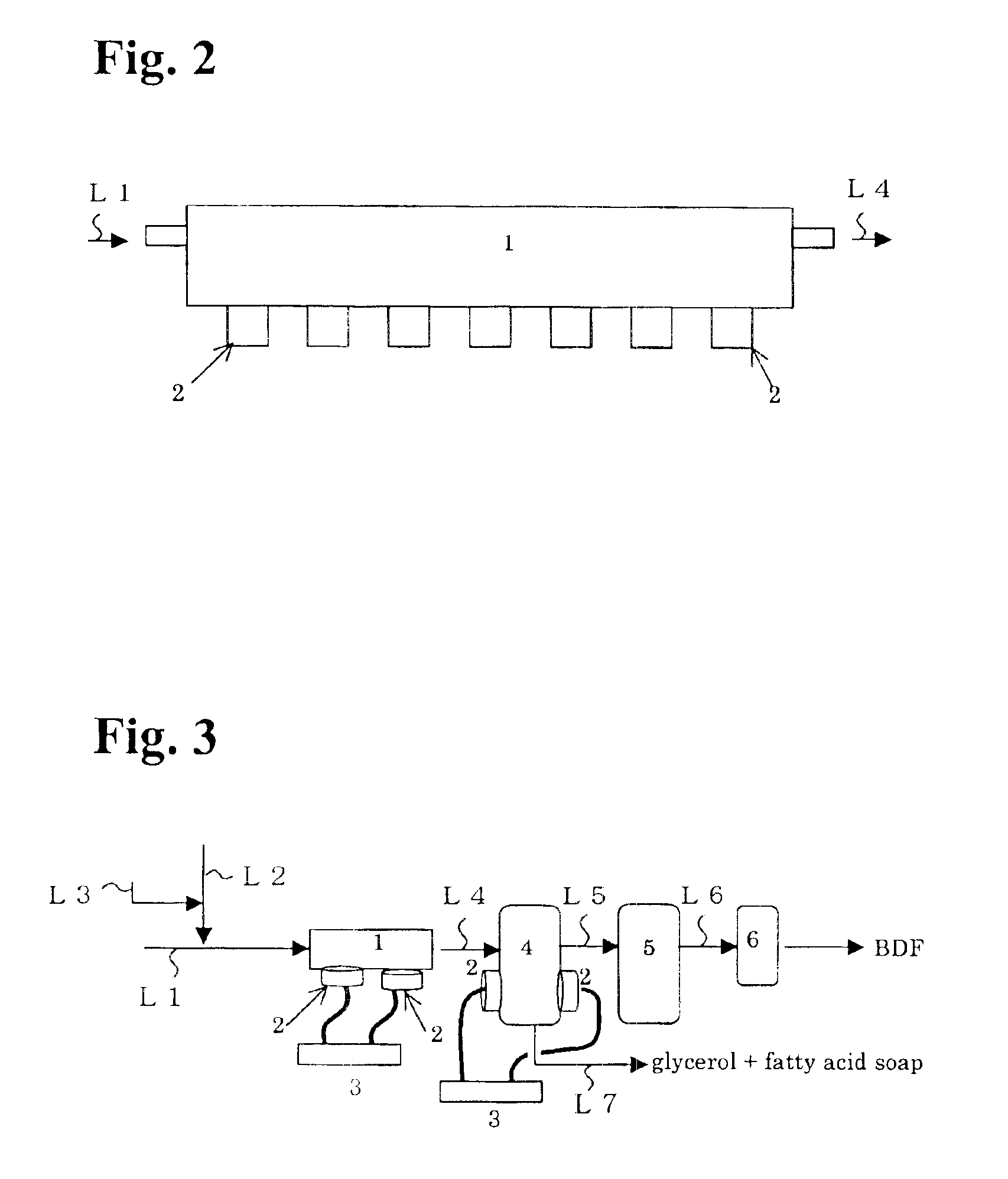Method for producing fatty acid alcohol ester
a technology of fatty acid alcohol and alcohol ester, which is applied in the direction of fatty acid chemical modification, fatty oil/acid recovery from waste, fatty oil/fat refining, etc. it can solve the problems of increasing the cost of production, so as to improve the reaction efficiency and reduce the cost of production. , the effect of improving the content of sulfur oxides
- Summary
- Abstract
- Description
- Claims
- Application Information
AI Technical Summary
Benefits of technology
Problems solved by technology
Method used
Image
Examples
examples 2 to 4
[0080]According to a process shown in FIG. 3, the ester interchange reaction was carried out under a condition shown in Table 2 below using a commercially available rapeseed oil as a starting oil, methanol as an alcohol and potassium hydroxide as a catalyst. The result of Examples 2 to 4 is shown in Table 2.
[0081]
TABLE 2Ex. 2Ex. 3Ex. 4Fat or oilrapeseed oilrapeseed oilrapeseed oilReaction temperatureordinaryordinaryordinaryand pressureUltrasonic frequency 40 kHz40 kHz40 kHzUltrasonic intensity 0.5 W / cm2 0.5 W / cm2 0.5 W / cm2Reaction time 30 min.30 min.30 min.AgitationnononoQuantity of catalyst 0.5 wt % 0.5 wt % 0.5 wt %(wt % to fat or oil)Quantity of alcohol 20 wt %20 wt %20 wt %(wt % to fat or oil)Separation temperatureordinaryordinaryordinaryand pressureUltrasonic frequency1500 kHz35 kHz 0Ultrasonic intensity 10 W / cm210 W / cm2 0Irradiation time 10 sec.10 sec. 0Static separation time 20 min. 3 hrs 3 hrs . . .Yield of ester*1 98 wt %98 wt %98 wt %Yield of glycerol 22 wt %22 wt %22 wt...
examples 5 and 6
[0084]According to a process shown in FIG. 3, the ester interchange reaction was carried out under a condition shown in Table 3 below using a commercially available palm oil as a starting oil, methanol as an alcohol and potassium hydroxide as a catalyst. The result of Examples 5 and 6 is shown in Table 3.
[0085]
TABLE 3Ex. 5Ex. 6Fat or oilpalm oilpalm oilReaction temperature 50° C.50° C.and pressureordinaryordinaryUltrasonic frequency 40 kHz40 kHzUltrasonic intensity 0.5 W / cm2 0.5 W / cm2Reaction time 30 min.30 min.AgitationnonoQuantity of catalyst (wt % to fat or oil) 0.5 wt % 0.5 wt %Quantity of alcohol (wt % to fat or oil) 20 wt %20 wt %Separation temperature and pressureordinaryordinaryUltrasonic frequency1500 kHz 0Ultrasonic intensity 10 W / cm2 0Irradiation time 5 min. 0Static separation time 1 hr. 8 hrs . . .Yield of ester*1 96 wt %96 wt %Yield of glycerol layer*1 24 wt %24 wt %Yield of soap*1≦1 wt %≦1 wt %*1wt % to fat or oil
[0086]In Example 6 in which palm oil was used as st...
example 7
[0087]The ester interchange reaction was carried out in a similar manner as described in Example 1 except that the ultrasonic transducers 2 of the separation tank 4 are arranged to meet the interface between fatty acid alcohol ester and glycerol. The result of Example 7 is shown in Table 4.
[0088]
TABLE 4Ex. 7Fat or oilrapeseed oilReaction temperature and pressureordinaryUltrasonic frequency 28 kHzUltrasonic intensity 6 W / cm2Reaction time 15 min.AgitationnoQuantity of catalyst (wt % to fat or oil) 0.5 wt %Quantity of alcohol (wt % to fat or oil) 15 wt %Separation temperature and pressureordinaryUltrasonic frequency600 kHzUltrasonic intensity 6 W / cm2Irradiation time 3 min.Static separation time 3 min.Yield of ester*1 98 wt %Yield of glycerol layer*1 17 wt %Yield of soap*1≦1 wt %*1wt % to fat or oil
[0089]It has been found that such ultrasonic irradiation to the interface between fatty acid alcohol ester and glycerol in the separation tank 4 further improves the separating purification ...
PUM
| Property | Measurement | Unit |
|---|---|---|
| Percent by mass | aaaaa | aaaaa |
| Frequency | aaaaa | aaaaa |
| Frequency | aaaaa | aaaaa |
Abstract
Description
Claims
Application Information
 Login to View More
Login to View More - R&D
- Intellectual Property
- Life Sciences
- Materials
- Tech Scout
- Unparalleled Data Quality
- Higher Quality Content
- 60% Fewer Hallucinations
Browse by: Latest US Patents, China's latest patents, Technical Efficacy Thesaurus, Application Domain, Technology Topic, Popular Technical Reports.
© 2025 PatSnap. All rights reserved.Legal|Privacy policy|Modern Slavery Act Transparency Statement|Sitemap|About US| Contact US: help@patsnap.com



